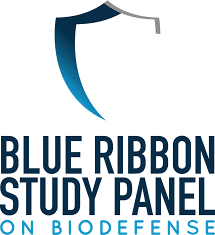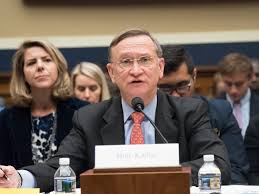National Biodefense Strategy
See the following -
A 'Very Graphic History' Of Germ Warfare
 Max Brooks, best-selling author of "World War Z" and non-resident fellow at the Modern War Institute at West Point, has partnered with the Blue Ribbon Study Panel on Biodefense to produce GERM WARFARE: A Very Graphic History. This highly stylized and engaging graphic novel, set for release this Saturday, depicts previous biological warfare events, the possibilities for the future, and the continued need for public health security. This is part of an effort by the bipartisan Panel to educate the public about biological risks and why a strong biodefense enterprise is critical to the health and security of the Nation.
Max Brooks, best-selling author of "World War Z" and non-resident fellow at the Modern War Institute at West Point, has partnered with the Blue Ribbon Study Panel on Biodefense to produce GERM WARFARE: A Very Graphic History. This highly stylized and engaging graphic novel, set for release this Saturday, depicts previous biological warfare events, the possibilities for the future, and the continued need for public health security. This is part of an effort by the bipartisan Panel to educate the public about biological risks and why a strong biodefense enterprise is critical to the health and security of the Nation.
- Login to post comments
Blue Ribbon Study Panel On Biodefense Receives $2.5 Million Grant To Reduce Risk of Catastrophic Bioweapon Disease Outbreaks
 The Blue Ribbon Study Panel on Biodefense announced today a $2.5 million grant from the Open Philanthropy Project. The grant allows the Panel to continue its leadership role in assessing our nation’s biodefense, issuing recommendations and advocating for their implementation, and identifying viable avenues for needed change to policy. The grant comes amidst heightened global tensions as North Korea and other regimes seek to develop biological weapons. It also arrives on the 100th anniversary of a catastrophic influenza pandemic that took the lives of millions around the world, a stark reminder of the dangers of biological events.
The Blue Ribbon Study Panel on Biodefense announced today a $2.5 million grant from the Open Philanthropy Project. The grant allows the Panel to continue its leadership role in assessing our nation’s biodefense, issuing recommendations and advocating for their implementation, and identifying viable avenues for needed change to policy. The grant comes amidst heightened global tensions as North Korea and other regimes seek to develop biological weapons. It also arrives on the 100th anniversary of a catastrophic influenza pandemic that took the lives of millions around the world, a stark reminder of the dangers of biological events.
- Login to post comments
Blue Ribbon Study Panel Recognizes National Security Strategy, Calls for Comprehensive Approach
 Senator Joseph Lieberman and Governor Tom Ridge, the co-chairs of the Blue Ribbon Study Panel on Biodefense, today addressed the newly updated U.S. National Security Strategy and the emphasis it places on combatting biological threats to the country. “With the release of the National Security Strategy, the Administration is sending a strong message to our enemies that America takes the biological threat seriously,” said Sen. Lieberman and Gov. Ridge.
Senator Joseph Lieberman and Governor Tom Ridge, the co-chairs of the Blue Ribbon Study Panel on Biodefense, today addressed the newly updated U.S. National Security Strategy and the emphasis it places on combatting biological threats to the country. “With the release of the National Security Strategy, the Administration is sending a strong message to our enemies that America takes the biological threat seriously,” said Sen. Lieberman and Gov. Ridge.
- Login to post comments
Is the US Finally Ready to Get Serious About Biodefense?
 Biological and other disaster threats - whether accidental, driven by forces of nature, or intentional - pose fairly grave risks to the United States and the world. Situational awareness has been a conspicuous topic ever since the 9/11 attacks and the anthrax scare that followed shortly thereafter. Since then we have experienced numerous disasters: health impacts of major weather events such as hurricanes and earthquakes, new virus outbreaks like Ebola in Africa, raging wildfires on the West Coast (I live in California), and the ever-present threat of pandemic flu which a hundred years ago infected some 500 million people across the globe and killed an estimated 50 million people worldwide, according to the Center for Disease Control and Preparedness (CDC). But since the initial flurry of public health preparedness funds in the ensuing several years after the 9/11 attacks, this topic has not had a high priority at CDC nor the funding necessary to implement it successfully.
Biological and other disaster threats - whether accidental, driven by forces of nature, or intentional - pose fairly grave risks to the United States and the world. Situational awareness has been a conspicuous topic ever since the 9/11 attacks and the anthrax scare that followed shortly thereafter. Since then we have experienced numerous disasters: health impacts of major weather events such as hurricanes and earthquakes, new virus outbreaks like Ebola in Africa, raging wildfires on the West Coast (I live in California), and the ever-present threat of pandemic flu which a hundred years ago infected some 500 million people across the globe and killed an estimated 50 million people worldwide, according to the Center for Disease Control and Preparedness (CDC). But since the initial flurry of public health preparedness funds in the ensuing several years after the 9/11 attacks, this topic has not had a high priority at CDC nor the funding necessary to implement it successfully.
- Login to post comments
National Biodefense Strategy: Protecting the Nation Against all Biological Threats
 Today, the White House and four federal departments unveiled a comprehensive National Biodefense Strategy to make America safer against modern biological threats to the United States. In the 21st century, biological threats are increasingly complex and dangerous, and that demands that we act with urgency and singular effort to save lives and protect Americans. Whether a natural outbreak, an accidental release, or a deliberate attack, biological threats are among the most serious we face, with the potential for significant health, economic and national security impacts. Therefore, promoting our health security is a national security imperative.
Today, the White House and four federal departments unveiled a comprehensive National Biodefense Strategy to make America safer against modern biological threats to the United States. In the 21st century, biological threats are increasingly complex and dangerous, and that demands that we act with urgency and singular effort to save lives and protect Americans. Whether a natural outbreak, an accidental release, or a deliberate attack, biological threats are among the most serious we face, with the potential for significant health, economic and national security impacts. Therefore, promoting our health security is a national security imperative.
- Login to post comments
Pandemic and all-hazards preparedness, response law emboldens U.S. disaster recovery efforts
 The Pandemic and All-Hazards Preparedness and Advancing (PAHPA) Innovation Act, S. 1379, became law on Monday with the president's signature, prompting accolades from national stakeholders, company executives and federal lawmakers. The far-reaching law ensures the United States will be better prepared to respond to a wide range of public health emergencies, whether man-made or occurring through a natural disaster or infectious disease. Overall, the law aims to bolster the nation's health security strategy, strengthen the country's emergency response workforce, prioritize a threat-based approach, and increase communication across the advanced research and development of medical countermeasures (MCMs), among numerous provisions contained in the law.
The Pandemic and All-Hazards Preparedness and Advancing (PAHPA) Innovation Act, S. 1379, became law on Monday with the president's signature, prompting accolades from national stakeholders, company executives and federal lawmakers. The far-reaching law ensures the United States will be better prepared to respond to a wide range of public health emergencies, whether man-made or occurring through a natural disaster or infectious disease. Overall, the law aims to bolster the nation's health security strategy, strengthen the country's emergency response workforce, prioritize a threat-based approach, and increase communication across the advanced research and development of medical countermeasures (MCMs), among numerous provisions contained in the law.
- Login to post comments
Ready or Not: New Report on Protecting the Public's Health
 The Trust for America's Health (TFAH) released its 2019 edition of what it hopes will be an annual report, Ready or Not: Protecting the Public's Health from Diseases, Disasters and Bioterrorism last February. The ground-breaking report warns about key global challenges ahead, like the risk of a flu pandemic; the impact of weather pattern changes due to climate change; the dangers of antimicrobial resistance, and others, and tries to offer advice on how to prepare for them.
The Trust for America's Health (TFAH) released its 2019 edition of what it hopes will be an annual report, Ready or Not: Protecting the Public's Health from Diseases, Disasters and Bioterrorism last February. The ground-breaking report warns about key global challenges ahead, like the risk of a flu pandemic; the impact of weather pattern changes due to climate change; the dangers of antimicrobial resistance, and others, and tries to offer advice on how to prepare for them.
- Login to post comments
Top White House Biodefense Official to Address Bipartisan Panel
 The Trump Administration recently released a National Biodefense Strategy to better defend the United States against myriad biological threats. The development and implementation of a comprehensive national biodefense strategy were among the top recommendations made by the bipartisan Blue Ribbon Study Panel on Biodefense in 2015. This Wednesday, November 14, the Panel will convene at the Hudson Institute in Washington, D.C. to gain a better understanding of how far the Executive Branch has come in implementing its National Blueprint for Biodefense.
The Trump Administration recently released a National Biodefense Strategy to better defend the United States against myriad biological threats. The development and implementation of a comprehensive national biodefense strategy were among the top recommendations made by the bipartisan Blue Ribbon Study Panel on Biodefense in 2015. This Wednesday, November 14, the Panel will convene at the Hudson Institute in Washington, D.C. to gain a better understanding of how far the Executive Branch has come in implementing its National Blueprint for Biodefense.
- Login to post comments